The birder’s paradise Uganda
The birder’s paradise Uganda
The birder’s paradise Uganda : Uganda is well known for being the Africa’s premier birding destination with over 1000 species. Many of these birds live only in th tropical forests with rare sightings being described as “mythical” while it is believed that some of the birds living in the remote forests of Uganda may not have been classified yet! This beautiful country must be on any birders bucket list and below is the list with some of the most common birds in Uganda.
Shoebill Stork (Balaeniceps rex)
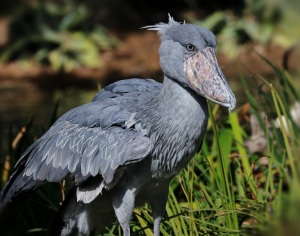
The shoebill also known as the “whale-headed stork”, birders from around the globe flock to Uganda to catch a rare glimpse of this clumsy giant. This shoe bill has highly distinctive, large, broad, clog-shaped bill. It often hunts for prey in pools that are drying out, feeding mainly on lungfish, frogs and small mammals. It frequently adopts an unusual method of hunting whereby it plunges on prey as if falling on it and then cuts up the food with a scissor-like action before swallowing. This shoebill breeds in almost inaccessible papyrus swamps and usually nests on floating vegetation and in hot weather, it pours water using its beak over the eggs to cool them.
Facts about the shoebill
- As its appearance shows this “Whale headed stork” was once thought to be a relative of the storks but its ability to fly with its neck retracted suggests affinity with pelicans or herons.
- The shoebill is generally grey and white when they mature to adult birds but younger juvenile ones are browner in appearance.
- They have very powerful wings which enable them to be swift as it flies or dives to get its prey.
- Shoebills primarily live in pairs “male & female” although groups may sometimes gather at favored feeding spots.
- Shoebills look sluggish and can stand motionless for long periods as it waits for its prey.
- They can walk very slowly through the murky waters with their bill in the waters for as long as 30 minutes but if something comes along, it simply thrusts its body forward and grabs it with its distinctive bill.
Where to find the shoebill
In Uganda it is easily seen in mabamba swamp on Lake Victoria, on the Nile below the Murchison falls and Lake Albert in Semuliki National Park.
Grey crowned crane (Balearica regulorum)

It is a bird in the crane family found in eastern and southern Africa and is the National bird of Uganda. It is often recognized for the golden ‘crown’ of feathers that stand tall and proud on its head.
Facts about the grey crowned crane
- The grey crowned crane is the national bird of Uganda and features in the country’s flag and coat of arms.
- The wings are predominantly white, but contain feathers with a range of colors, with a distinctive black patch at the very top.
- The head has a crown of stiff golden feathers, the sides of the face are white, and there is a bright red inflatable throat pouch.
- It is believed to live for up to 22 years in the wild and up to 25 years in captivity.
- The grey crowned crane has a breeding display involving dancing bowing and jumping which is an integral part of courtship, but also may be done at any time of the year.
- They are monogamous and once they are ready, they display behavior that helps to attract a mate for example they dance, bow and also jump.
- These cranes are omnivores, eating seeds, grain, plants, snakes, frogs, insects, worms, small fish and the eggs of aquatic animals.
- They lay 2-5 eggs that they keep in the nests built on a flat and circular platform using the grass and some other available plant and incubation takes 28-31 days.
Where to find the Grey Crowned Crane
In Uganda they can be found in marshes, cultivated lands and grassy flatlands near rivers and lakes.
Scarlet-Chested Sunbird (Chalcomitra senegalensis)
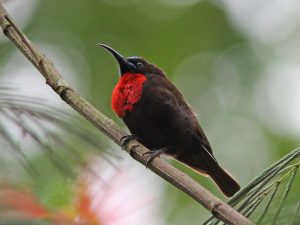
The Scarlet-chested sunbird is one of the more common species in Uganda, jet-black with a bold scarlet chest patch and green head markings.
Facts about Scarlet-chested sunbird
- The female scarlet-chested sunbird lays 2-3 eggs.
- The adult male has a brilliant scarlet breast and small iridescent green cap and green throat.
- The male defends the breeding territory.
- The immature male and female birds look alike with some dull red feathers on the breast and a blackish throat.
- The nest is pear-shaped with a hood over the entrance hole and suspended from a branch. It is built by the female using dry grass, stems, leaves and bound by spider web.
Where to find the Scarlet-chested sunbird
They can be seen in most of Uganda’s forest and National Parks like Kidepo valley National Park and Kibale Forest National Park.
Papyrus Gonolek (Laniarius mufumbiri)
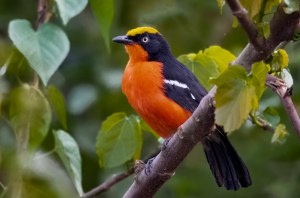
The papyrus gonolek is a medium-sized bush-shrike with 18 cm (7 in) long. The sexes are similar; the crown is dull yellow, the head, upper parts, wings and tail are black apart from a broad white bar on the wings. The breast and upper belly are vivid orange-crimson, and the lower belly whitish. It has specialized habitat requirements, being restricted to papyrus swamps.
Facts about the papyrus Gonolek
- The species occurs singly or in pairs in papyrus swamps, lurking among the vegetation and only flying occasionally, usually a short distance over water to another patch of papyrus.
- Its diet consists of mainly insects such as beetles, flies and ants, but also includes snails, fruit and seeds when available.
- The nest is probably built in a small bush in reedbeds.
- Its presence can often be detected by its “U-tzeu-U-tzee”.
- This African bird is locally common but quite shy and you might find it difficult to observe in dense papyrus swamps.
Where to find a Papyrus Gonolek
In Uganda, the mabamba swamp would be the best site to view these birds during your birding tour.
Great Blue Turaco (corythaeola cristata)

The Great blue turaco as well as the white-crested turaco are some of the largest, most exquisite birds found in Uganda. These birds are actively hunted as their meat and feathers are highly sought-after commodities. The Great blue turaco feeds primarily on fruits from numerous plant species, but it also takes buds, shoots, leaves and flowers, and occasionally some insects. The feeding mostly takes place the whole day round and, in the evening, while the chicks are fed with regurgitated leaves.
Facts about the Great Blue Turaco
- Turacos in general, however, may have the looks, but they don’t have the moves. Physically, they have short, round wings that make “flying” a little more like “gliding” when they make a leap from one tree to another.
- They feed on shoots, buds, and leaves and will indulge occasionally on insects if the mood strikes them.
- They are most commonly heard at dawn and dusk and during mating seasons and their primarily call is a harsh and deep tone that almost sounds like they are repeating the word “cow” over and over.
- During courtship which begins around October, they are very entertaining, male turacos try to entice their prospective mates by calling loudly and raising and lowering the large crest on their heads.
- Females will typically lay 2 blue eggs and parents take turns incubating them for about a month.
- Turacos in general are shy and typically do not come down to ground level except to drink or bathe.
- Great blue turacos are hunted for their meat as well as their feathers.
Where to find the Great Blue Turaco
In Uganda they can be found near the shores of Lake Victoria in the trees.
African Paradise Flycatcher (Elminia longicauda)
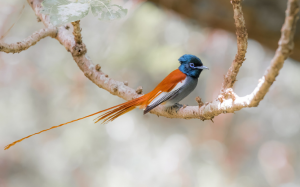
It is a common resident breeder in Africa south of the Sahara Desert. The female has a browner tint to the under parts and lacks the wing bar and tail streamers while an adult male has a slightly crested black or blue-black head merging into grey under parts while the mantle, wings and tail is white instead of chestnut. Young birds are similar to the female but duller.
Facts about an African Paradise Flycatcher
- It is insectivorous, often hunting by catching flies on the wing, and eating eggs, larvae and adults.
- It has a cup-shaped nest always built in a tree and a clutch of two or three eggs are laid.
- The African paradise flycatcher is a noisy bird with a harsh scolding, nasal and cheerful warbling which sometimes breaks into a rhythmical Pi-pi-pi-pi-pi-pi-pi-pi-piiii.
- The male bird has the spectacular long plumed tail streamers which can be either white or rufous brown.
Where to find an African Paradise flycatcher
In Uganda they can be seen in open grassland with isolated trees, plantations, open woodland, scrubland, gardens, in National parks like Kibale National Park in the Eastern parts of the country.
African Thrush (Turdus pelios)

The African thrush has dark olive-grey upper parts with a whitish evenly brown-streaked side throat, the breast, the belly and vent are white whereas its bill is yellow-orange.
Facts about the African Thrush
- Breeding is recorded in all months but very active in the wet seasons.
- The African thrush is normally encountered either singly or in pairs, rather shy and retiring preferring to remain in cover but will come out and gather at fruiting trees.
- Its nest is cup shaped, rather bulky and is constructed using plant fibers and mud lined with fine grasses, leaves and roots.
- The female lays 2-3 eggs and both sexes participate in feeding the young ones.
- The song of the African thrush is a sustained, clear warbling made up of different phrases repeated rather randomly in a sequence.
Where to find an African Thrush
It is common in well-wooded areas over much of western park of sub-saharan Africa.
Yellow Billed Kite (milvus aegyptius)

This is one of the most common and visible birds of prey on the African continent. The yellow billed kite and white kite are very similar in appearance, and their range overlap when black kites migrate south from Europe and Asia and into Africa during the northern winter. The easiest way to tell their difference is by looking at the beak whereby the yellow-billed kite has an all-yellow beak, whereas the black kite has a black tip to its beak.
Facts about the Yellow Billed Kite
- It is an all-brown bird often with a lighter grey-brown head and a forked tail.
- It is a migratory bird in the areas where seasons are moved varied, and is only resident in tropical areas close to the equator.
- It is a gregarious bird, and will sometimes come together in large numbers when food is plentiful.
- Nests are made up of sticks and twigs and are constructed on tree branches, cliff ledges, pylons and on buildings.
- The female lays 2-3 eggs and incubates them for about 30 days and chicks leave the nest after 42-56 days, but will depend on both parents for another 15-50 days.
Where to find the Yellow Billed Kite
They are found in almost all habitats and you can also find them in Ugandan National Parks like Murchison falls national Park, Kidepo Valley National Park and much more.
African Jacana (Actophilornis africanus)
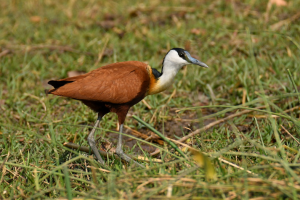
African jacana is identified by long toes and long claws that enables them walk on floating vegetation in shallow lakes. They have chestnut upper parts with black wingtips, rear neck, and eye stripe. The underparts are also chestnut in the adults whereas juveniles are white with a chestnut belly patch. The bill extends up as a coot-like head shield, and the legs and long toes are grey.
Facts about the African Jacana
- The adult bird is 32 cm in height. Sexes are similar but the female bird is slightly larger than the male.
- They are very noisy, calling a series of rapid repeated shrill squeals & rattling notes.
- They lay 4 black-marked brown eggs in a floating nest.
- The female birds display secondary sex characteristics.
- They feed on water-lilies, insects, aquatic larvae and water seeds.
- The adult is a striking chestnut and white-water bird with a blue bill and a frontal shield.
- Usually, you will find the African jacana singly or in pairs & sometimes in congregations.
Where to find the African Jacana
A trip along Lake Victoria, Lake Albert or Lake Edward will lead you to the beautiful views of the African jacana.
African fish Eagle (Haliaeetus vocifer)

It is a large species of eagle found throughout sub-Saharan Africa where large bodies of open water with an abundant food supply occur. The adult is very distinctive in appearance with a mostly brown body with a white head like the bald eagle and large, powerful, black wings. The head, breast and tail of African fish eagles are snow white, with the exception of the featherless face, which is yellow. The eyes are dark brown in color with a hook-shaped beak, ideal for a carnivorous lifestyle.
Facts about an African Fish Eagle
- The female, at 3.2-3.6 kg (7.1-7.9 Ib) is larger than the male, at 2.0-2.5kg.
- African fish eagle breed during the dry season when water levels are low and they are believed to mate for life.
- The female lays 1-3 eggs, which are primarily white with a few reddish speckles and incubation is mostly done by the female; the male incubates when the female leaves to hunt and incubation lasts for 42 to 45 days before the chicks hatch.
- The African fish eagle feeds mainly on fish, which it swoops down upon from a perch in a tree, snatching the prey from the water with its large, clawed talons.
- It is the national bird found on the coat of arms of Namibia, Zimbabwe and South Sudan.
- The African fish eagle is notable for its high attractive call wee weee…wuwuwu.
- Pairs also duet, one can call wi and other immediately replies woo.
- African fish eagle are stunning fishers and make marvelous stoops at fish as heavy as 10kg.
Where to find the African Fish Eagle
The bird is a resident on most lakes in Uganda and waterways but you will see it much easier in Mabamba wetland.
African Skimmer (Rynchops flavirostris)
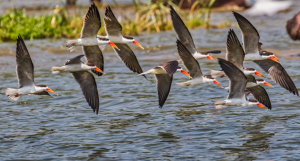
African skimmers have long wings, with a black hindneck, and crown. The forehead and rest of the body is white, with a bright, long orange beak that ends with a yellow tip (black tip when immature). Their short-forked tail is white, and their legs are bright red. The African skimmer is generally uncommon and the total populations is estimated at 15,000-25,000 individuals.
Facts about the African skimmer
- Their bill structure is unique; the lower mandible is much longer than the upper mandible and is flattened sideways like scissor blades.
- African skimmers fly in lines over calm waters, and dip their lower mandibles in the water to feed.
- They live at large tropical rivers with sandbanks for nesting and roosting.
- They feed mostly at dawn and dusk and have good night vision.
- Their voice is a sharp “kip-kip”
- The colonies typically consists of less than 50 pairs and each pair lays 2-3 (rarely 4) eggs in a scrape in the sand.
- The fish has been recorded as prey for African skimmers.
- The immature bird is pale brown above with a shorter black bill and dull yellow legs.
Where to find the African Skimmer
You will often see this bird flocked on the sandbanks or skimming above the water in Queen Elizabeth National Park.
Hamerkop (Scopus umpretta)
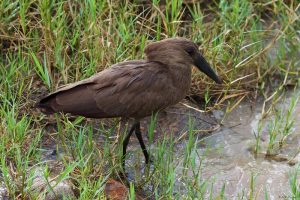
The hamerkop is a medium-sized water bird, the tail is faintly barred with darker brown. The sexes are likely and fledglings resembled adults the bill is long, 80 to 85mm (3.1-3.3 in), and slightly hooked at the end. It resembles the bill of a shoebill and its quite compressed and thin, particularly at the lower half of the mandible. The bill is brown in young birds, but becomes black by the time a bird fledges.
Facts about the Hamerkop
- The hamerkop has, for unknown reasons, partially webbed feet.
- Its tail is short and its wings are big, wide, and round-tipped.
- The hamerkop is mostly active during the day, often resting at noon during the heat of the day.
- The only call it usually makes when alone is flight-call, a shrill “nyip” or “kek”.
- The hamerkop is mostly silent when alone, but is fairly vocal when in pairs or in groups.
- This species normally feeds alone or in pairs but also feeds in large flocks sometimes.
- A bird flies slowly low over the water with legs dangling and head looking down, then dipping feet down and hovering momentarily when prey is sighted.
- The diet also includes shrimp, insects and rodents.
- Nests have been recorded to take between 10 & 14 weeks to build.
- It may shuffle one foot at a time on the bottom or suddenly open its wings to flush prey out of hiding.
Where to find the Hamerkop
In Uganda this bird is always seen on the shores of most Lakes and in some swamps.
Pied Kingfisher (cesyle rudis)
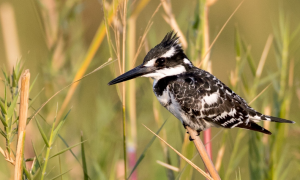
This bird is about 17cm long, white with a black mask, a white supercilium and black breast bands. The crest is neat and the upper parts are barred in black.
Facts about the Pied Kingfisher
- You will know it is male if it has a narrow second breast band and you will know it is female if it has a single broken breast band.
- The pied kingfisher will normally have a clutch of 3-6 white eggs.
- The pied kingfisher is mostly resident and doesn’t migrate except for short distances and seasonal movements.
- This African bird feeds mainly on fish, although it will also feed on crustaceans and large aquatic insects such as dragon fly larvae.
- The bird nests in holes excavated in a vertical mud bank about five feet above water.
- The nest tunnel is about 4-5 feet deep and ends in a chamber.
Where to find the Pied Kingfisher in Uganda
In Uganda, you will find the pied kingfisher mainly around Lake Victoria and in Murchison Falls National Park.
Saddle-Billed Stork (Ephippiorhynchus senegalensis)
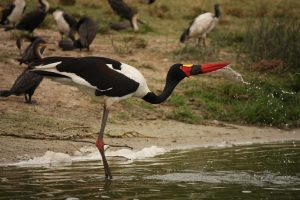
This is a very large black and white stork with about 142 cm long, with a very long tri-colored bill, red and black with a yellow saddle and two small pendulous yellow or red wattles. The bird is spectacularly plumaged having the head, neck, back, wings and tail black, and the rest of the body and the primary flight feathers are also white. This African bird has very long legs with pink knees and feet.
Facts about the Saddle-Billed stork
- The male saddle-billed stork has dark eyes, while the female is slightly smaller and has yellow eyes.
- The immature birds are largely dingy grey-brown colored with some white patches on the back, a blackish bill which lacks the saddle and duller legs.
- Like most storks, the saddle-billed stork flies with the neck out-stretched, not retracted like herons.
- While in flight, the large heavy bill is kept drooping somewhat below belly height, giving the bird a very unusual appearance.
- Saddle-billed storks are usually silent birds, but when breeding the birds give descending squealing wheezes.
- It feeds mainly on fish, frogs and crabs, but can also feed on small reptiles.
- It moves in a deliberate and stately manner as it hunts, in a way similar to the larger herons.
Where to find the saddle-billed stork
This Uganda bird feeds in marshes, forested water lands, other highlands and in tropical lowlands. In Uganda you will easily see these on game drive north of Murchison falls and at kazinga channel.
Secretary bird (Sagittarius serpentarius)

With its stork-like, long, wedge-shaped tail and crest of black feathers on the back of its head, the secretary bird is unlike any other raptor. The crest resembles a number of quill pens, as used in the past by secretaries.
Facts about the secretary bird
- Its flight feathers are black.
- The powerful legs are used for striking prey and running after faster quarry.
- This bird walks up to 24km (15miles) a day through grasslands searching for prey.
- It feeds on grasshoppers, small mammals, frogs, snakes, lizards and tortoises.
- The bird flushes out the prey by stamping on tufts of grass.
- The wings act as shields when the bird attacks snakes.
Where to find the secretary Bird
On your birding tour in Uganda, you will have high chances of viewing this bird when you visit Queen Elizabeth National Park and Kidepo valley national park.
Please note that on your birding trip, you may need birding binoculars, an ethnology book for better identification of Uganda birds. For all your birding trips in Uganda, please feel free to contact us.








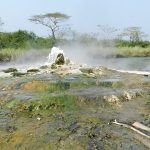
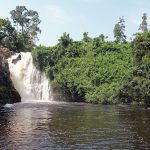

Leave a Reply
Want to join the discussion?Feel free to contribute!